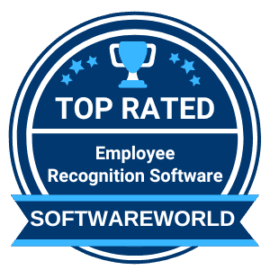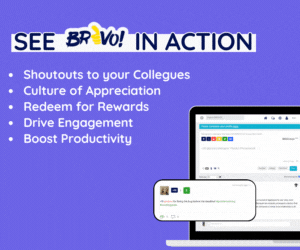
In today’s rapidly evolving business landscape, organizations must adapt and innovate to stay competitive.
Gamification in the workplace can transform a business by revolutionizing employee engagement, motivation, and overall productivity.
Employees are motivated to participate, collaborate, and excel in their tasks by introducing game-like elements and practices into daily work activities.
With increased engagement and productivity, a workplace can be transformed into a dynamic and vibrant place where employees thrive, productivity soars, and the organization achieves sustainable success.
This blog post will delve into how gamification can contribute to achieving excellence by enhancing employee motivation, retention, and performance. Let’s explore this topic further.
What is the Importance of Gamification in the Workplace?
Gamification in the workplace holds significant importance as it introduces elements of play, competition, and rewards into the work environment, leading to improved employee engagement, motivation, and productivity.
Gamification leverages game-like elements like challenges, points, levels, and leaderboards to tap into humans’ inherent drive for accomplishment and pleasure.

This approach fosters a lively, constructive environment that encourages teamwork, collaboration, and healthy employee competition.
Research shows that 72% of employees are inspired to work harder when gamification is implemented.
Gamification provides a sense of purpose and accomplishment, as employees receive immediate feedback and recognition for their efforts, enhancing job satisfaction and overall morale.
How Do You Gamify in the Workplace?
The process of gamification in the workplace involves incorporating game design elements and mechanics into the work environment to increase employee motivation, engagement, and productivity.
Several strategies can be used to achieve this.
One practical approach is to establish clear goals and objectives, similar to quests or missions, that employees can work towards individually or as part of a team.
Implementing reward and recognition systems allows achievements to be acknowledged and celebrated, fostering a sense of accomplishment and friendly competition.
Displaying leaderboards and performance metrics helps create a feeling of progress and encourages healthy competition.
Moreover, integrating game-like elements into regular tasks can make them more enjoyable and stimulating.
Through the integration of gamification in the workplace, organizations can foster a favorable and dynamic environment that uplifts employee morale and stimulates performance.
Gamification Principles and Techniques
Gamification principles and techniques form the foundation of creating engaging and motivating experiences in the workplace.
These principles are rooted in understanding human psychology and behavior, leveraging intrinsic motivators to drive desired outcomes.
One fundamental principle is the use of clear goals and objectives. By defining specific targets, employees have a sense of direction and purpose, knowing what they need to achieve. Another principle is providing real-time feedback and recognition.
Regular feedback helps employees track their progress, identify areas for improvement, and stay motivated. Recognition, in the form of virtual badges or leaderboards, taps into our need for achievement and social validation.
Additionally, gamification techniques often incorporate elements of competition, introducing challenges and friendly rivalries to encourage higher performance levels.
Collaboration is also emphasized, with team-based challenges fostering cooperation and creating a sense of shared accomplishment.
Gamification in the workplace may provide extrinsic motivators and incentives for employees to participate and excel actively.
Furthermore, the element of surprise, such as unlocking hidden features or unexpected rewards, can enhance engagement and excitement.
Effective gamification in the workplace also embraces progress tracking and visualizations, allowing employees to see their advancements and celebrate milestones.
By leveraging these gamification principles and techniques, organizations can create a motivating and engaging work environment that drives employee performance, learning, collaboration, and overall satisfaction.
Key Components and Elements of Gamification in the Workplace
The key components and elements of gamification in the workplace are essential for creating a successful gamified experience that motivates and engages employees.
One crucial component is the establishment of clear goals and objectives.
These goals provide a sense of direction and purpose, giving employees something to strive for and a clear understanding of what is expected.
Another vital component is using game mechanics, such as points, badges, and leaderboards. Points measure progress, while badges symbolize achievement, recognizing employees’ accomplishments.

Leaderboards create a sense of competition and allow employees to compare their performance with others, fostering a friendly rivalry that drives engagement.
Feedback and recognition are also integral elements of gamification.
Timely and constructive feedback helps employees understand their strengths and areas for improvement.
At the same time, recognition in the form of virtual rewards or public praise reinforces desired behaviors and motivates employees to excel.
Progress tracking is another key element, allowing employees to visualize their progress and see how far they have come, providing a sense of accomplishment.
Collaborative elements, such as team challenges or cooperative quests, promote teamwork and encourage employees to work together towards shared goals.
Additionally, gamification in the workplace often incorporates a sense of unpredictability or surprise, offering unexpected rewards or unlocking hidden features, adding an element of excitement and intrigue to the gamified experience.
Through the integration of these essential components and elements, organizations can establish a gamification framework that nurtures employee engagement and motivation, leading to the achievement of desired outcomes within the workplace.
How Can Gamification Improve Employee Motivation and Performance?
Enhancing employee motivation and performance is critical to organizational success, and gamification offers a powerful approach to achieving this. Incorporating game elements into the workplace makes employees more likely to be engaged and motivated to perform at their best.
Gamification in the workplace provides a sense of challenge and excitement, making tasks more enjoyable and stimulating. It taps into employees’ intrinsic motivators, such as the desire for achievement, recognition, and personal growth.

Through gamified experiences, employees can set clear goals, receive real-time feedback, and earn rewards or badges for their accomplishments.
It boosts their self-confidence, satisfaction, and overall motivation. Gamification in the workplace also fosters a sense of individual and team competition, which can drive employees to push their boundaries and strive for excellence.
Through the implementation of gamification to enhance employee engagement and motivation, organizations can cultivate a work environment that is both more productive and positive. It, in turn, results in improved performance, heightened levels of job satisfaction, and, ultimately, better business outcomes.
How Gamification Boosts Employee Engagement?
Gamification has a significant impact on boosting employee engagement in the workplace. Game-like elements motivate employees to participate and immerse themselves in their work actively.
Gamification in the workplace creates a sense of excitement and enjoyment, making tasks more compelling and stimulating. It taps into employees’ natural desire for achievement, recognition, and progression.
The element of competition fosters a healthy drive to outperform and excel, encouraging employees to give their best efforts.
Moreover, gamification in the workplace promotes a sense of autonomy and empowerment, as employees have the freedom to make choices and explore different paths within the gamified framework.
By using gamification to enhance employee engagement, organizations can establish a more motivated, dedicated, and productive workforce. It, in turn, leads to heightened job satisfaction and an overall improvement in performance.
Using Game Elements to Motivate and Inspire Employees
Using game elements to motivate and inspire employees is a powerful strategy that taps into their intrinsic motivation and fosters a sense of enthusiasm in the workplace.
Organizations can create an environment that ignites employees’ passion and drives by incorporating Gamification.
These elements provide a clear structure and progression that employees can follow, giving them a sense of purpose and direction in their work.
Rewards and recognition, such as virtual badges or leaderboards, acknowledge employees’ achievements and provide a sense of accomplishment.
Game elements also introduce an element of fun and excitement, making tasks more enjoyable and engaging.
By strategically implementing game elements, organizations can establish a work environment that ignites creativity, fosters a culture of continuous improvement, and inspires employees to push their performance to new heights.
Gamification for Fostering a Sense of Purpose and Accomplishment
A gamification is a powerful tool for fostering a sense of purpose and accomplishment among employees.
It can motivate employees to pursue meaningful objectives and experience a sense of fulfillment in their achievement.
Gamification in the workplace provides employees with a clear sense of purpose by aligning their tasks and activities with larger goals and objectives.
As they progress and receive real-time feedback, employees gain a heightened sense of accomplishment, boosting their self-confidence and job satisfaction.
Using rewards, badges, or leaderboards further reinforces their achievements, creating a sense of recognition and pride.
Gamification in the workplace instills a sense of purpose by transforming mundane tasks into meaningful challenges, fueling employees’ intrinsic motivation, and inspiring them to take ownership of their work.
As a result, employees feel a greater sense of purpose and accomplishment, leading to increased engagement, productivity, and overall satisfaction in the workplace.
Promoting Collaboration and Teamwork
Promoting collaboration and teamwork is essential for fostering a productive and harmonious work environment, and gamification provides a practical approach to achieving this.
Gamification in the workplace helps employees to collaborate and work together towards a common objective.

Gamification encourages employees to share knowledge, skills, and resources, fostering a culture of cooperation and synergy.
Through gamified experiences, employees can develop a sense of camaraderie and trust as they rely on each other’s strengths and expertise to overcome challenges.
The competitive elements of gamification can also drive healthy competition among teams, inspiring them to strive for excellence while maintaining a collaborative spirit.
By promoting collaboration and teamwork through gamification, organizations can break down silos, improve communication, and harness their workforce’s collective intelligence and creativity, leading to more innovative solutions, improved problem-solving, and, ultimately, better business outcomes.
Team-based Challenges and Competitions to Foster Cooperation
Team-based challenges and competitions play a vital role in fostering cooperation and collaboration within the workplace.
By introducing gamification elements that encourage teams to compete and work together towards a shared goal, organizations can create a sense of camaraderie and teamwork among employees.
These challenges allow team members to leverage their unique skills and strengths, fostering a sense of interdependence and trust.
Moreover, team-based competitions encourage open communication, idea-sharing, and the pooling of resources, as individuals work collectively to achieve success.
The friendly rivalry from these challenges enhances engagement and motivation and promotes a positive and supportive work environment.
Organizations can foster cooperation, strengthen team dynamics, and achieve remarkable results through a collective effort by incorporating team-based challenges and competitions into gamification strategies.
Building a Collaborative Work Environment Through Gamification
A collaborative work environment is crucial for organizations fostering innovation, productivity, and overall success.
Gamification provides an effective means to promote collaboration and create a culture of teamwork within the workplace.
Through gamification in the workplace, employees can leverage each other’s strengths, support one another, and collectively solve complex problems.
This collaborative approach enhances communication, builds trust, and fosters a sense of collective ownership and accountability.
By nurturing a collaborative work environment through gamification, organizations can unleash the full potential of their workforce, drive innovation, and achieve remarkable outcomes.
Goals and Performance Tracking
Goals are fundamental to success in any endeavor, and gamification in the workplace provides a robust framework for implementing this in the workplace.
By incorporating goal-setting mechanisms and progress-tracking features into gamified experiences, employees are motivated to strive for specific targets and monitor their advancement.
Setting clear goals gives employees a sense of direction and purpose, guiding their efforts toward desired outcomes.
Gamification in the workplace enables employees to visualize their progress through visual cues, progress bars, or milestone achievements, which enhances their sense of accomplishment and keeps them engaged.
Moreover, real-time progress tracking allows employees to assess their performance, identify areas for improvement, and make necessary adjustments.
This iterative process of setting goals, tracking progress, and making improvements promote continuous learning and growth, ultimately leading to increased productivity and personal development.
Organizations can foster a results-oriented culture, enhance employee performance, and drive success by integrating goal-setting and progress tracking into gamification strategies.
Tracking Employee Progress and Performance Using Gamification Metrics
Tracking employee progress and performance using gamification metrics is valuable for organizations to gain insights into their workforce and drive continuous improvement.
Organizations can monitor employee performance transparently and engagingly by incorporating gamification elements.
These gamification metrics provide tangible indicators of progress and achievement, allowing employees to visualize their growth and accomplishments.
Additionally, tracking employee progress through gamification metrics enables managers and leaders to provide timely feedback, recognize top performers, and identify areas where additional support or training may be needed.
By leveraging gamification metrics, organizations can create a data-driven culture that promotes accountability, healthy competition, and a focus on excellence.
It, in turn, empowers employees to take ownership of their development, fosters a sense of achievement, and drives overall performance and productivity.
Providing Feedback and Recognition for Achievement and Progress
Providing feedback and recognition for achievement and progress is essential to fostering growth and motivation in individuals.
When individuals receive feedback on their accomplishments, it acknowledges their hard work and provides them with valuable insights into their strengths and areas for improvement.
Constructive feedback helps individuals refine their skills and enhance their performance, leading to continuous improvement.
Additionally, recognizing achievements and progress boosts morale and self-confidence, encouraging individuals to strive for further success.
Offering timely and specific feedback and recognizing the efforts and accomplishments of individuals, organizations, and leaders create a supportive and empowering environment that fuels motivation and propels individuals toward more significant achievements.
Driving Productivity and Performance
Productivity and performance are crucial for organizations aiming to thrive in today’s competitive landscape.
Businesses can maximize their output and achieve desired outcomes by fostering an environment that promotes efficiency and effectiveness. Encouraging productivity involves:
- Setting clear goals and expectations.
- Providing employees with the necessary resources and tools.
- Offering support and guidance when needed.
Moreover, it involves implementing time management techniques, effective communication channels, and streamlined processes.
Recognizing and rewarding high performance also plays a vital role in driving productivity, as it motivates individuals to exceed expectations and consistently deliver exceptional results.
Organizations can optimize their operations by prioritizing productivity and performance, enhancing customer satisfaction, and achieving long-term success.
Impact of Gamification on Employee Productivity
The impact of gamification on employee productivity is noteworthy and has gained traction in various organizations.
Gamification elements can significantly boost employee engagement and productivity. Games have an innate ability to tap into individuals’ intrinsic motivation and drive, making work tasks more enjoyable and stimulating.
Gamification in the workplace also promotes a sense of friendly competition among employees, inspiring them to strive for better performance and surpass their limits.
Additionally, it provides immediate feedback and a sense of progress, reinforcing positive behaviors and encouraging continuous improvement.
Incorporating gamification in the workplace can energize employees, enhance their focus and creativity, and ultimately lead to increased productivity and goal achievement.
Enhancing Performance Through Gamified Incentives and Rewards
Enhancing performance through gamified incentives and rewards has proven to be a highly effective strategy in motivating individuals to excel in their work.
By implementing gamification elements, organizations create a sense of achievement and recognition that drives employees to go the extra mile.
These gamified incentives provide clear goals and milestones for employees to strive towards, instilling a sense of purpose and direction.
Moreover, they tap into individuals’ competitive spirit, fostering healthy competition among team members and continually pushing them to improve their performance.
The immediate and tangible rewards offered through gamification in the workplace reinforce desired behaviors and create a positive feedback loop, encouraging employees to exceed expectations consistently.
Ultimately, by leveraging gamified incentives and rewards, organizations can enhance employee performance, boost morale, and cultivate a high-performance culture that leads to exceptional results.
Using Gamification to Drive Continuous Improvement and Goal Attainment
Gamification in the workplace drives continuous improvement and goal attainment in organizations.
By incorporating game elements into tasks, projects, and learning initiatives, gamification in the workplace motivates employees to engage in self-improvement and strive for higher performance levels.
Challenges, milestones, and progress tracking create a sense of achievement and progress, encouraging individuals to push their boundaries and continuously improve their skills.
Gamification in the workplace also promotes a growth mindset by providing immediate feedback, allowing individuals to identify areas for improvement and take targeted actions to enhance their performance.
Furthermore, setting clear goals and offering rewards and recognition for goal attainment creates a sense of purpose and satisfaction, further fueling the drive for continuous improvement.
Overall, gamification in the workplace provides a fun and engaging way to foster a culture of continuous learning, improvement, and goal attainment within organizations.
How Can a Quality Employee Gamification Platform Help Achieve Excellence?
A quality employee gamification platform has the power to transform your workforce in remarkable ways.
A gamification platform can significantly enhance employee engagement, motivation, and productivity by integrating game elements into various aspects of work, such as goal setting, performance management, rewards, and recognition.
It creates a dynamic and interactive environment that appeals to employees’ intrinsic motivation, making tasks more enjoyable and stimulating.
The platform provides immediate feedback, recognition, and rewards, fostering a sense of accomplishment and driving continuous improvement.
Moreover, it encourages healthy competition among employees, spurring them to strive for excellence and surpass their limits.
By promoting a culture of learning, collaboration, and goal attainment, a quality employee gamification platform can unleash the full potential of your workforce, leading to increased job satisfaction, higher retention rates, and, ultimately, improved business outcomes.
BRAVO is a robust and comprehensive employee gamification platform helpful in transforming the workforce of any organization. Its point-based recognition boosts employee engagement and promotes a culture of recognition.
It allows businesses to create customized challenges, reward systems, and leaderboards, fostering a sense of competition and achievement among participants.
BRAVO’s gamification is highly effective for boosting employee engagement, motivation, and a sense of competition and achievement in the workforce.
It fosters a culture of celebration that inspires individuals to come together and cultivate a collective sense of purpose, emphasizing the significance of collaborative efforts towards shared goals.
If you want to achieve excellence in your workforce, implement BRAVO’s gamification today! Book a demo with our experts to learn how to implement it and transform your workforce for boosted engagement and productivity.






